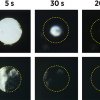
Topical antiviral gels have the capacity to kill the HIV virus within the vagina, and so allow a woman to protect herself, but they lack certain characteristics that would make them practical in the real world. One problem is that the gel has to deliver a high dose of the antiviral agent, which is essentially achieved by using a lot of gel – a potentially leaky proposition. Solid products like films and tablets take a good deal of time to dissolve, potentially leaving a window during which the microbes can pass to the woman without resistance. Researchers at the University of Washington have developed a new fabric that has the medication embedded within itself, and the fibers of which quickly dissolve once introduced to moisture.
The material is made primarily from a polymer and maraviroc, an antiretroviral drug, electrospun into a fiber with a high surface area. This high surface area allows about 30% of the material to be composed of the drug, compared to approximately 3% in topical gels. The combination of a high dose and quick absorption resulting from the new material may allow for special HIV preventing tampons that can be inserted into the vagina just prior to sexual intercourse.
Some details from the study abstract:
We formulate maraviroc at up to 28 wt% into electrospun solid dispersions made from either polyvinylpyrrolidone or poly(ethylene oxide) nano- or micro-fibers, and investigate the role of drug loading, distribution, and crystallinity in determining drug release rates into aqueous media. We show that water-soluble electrospun materials can rapidly release maraviroc upon contact with moisture, and that drug delivery is faster (less than 6 minutes under sink conditions) when maraviroc is electrospun in polyvinylpyrrolidone fibers containing an excipient wetting agent. These materials offer an alternative dosage form to current pericoital microbicides.
source:University of Washington
Electrospun Dissolvable Material To Make Tampons That Prevent HIV Infections

